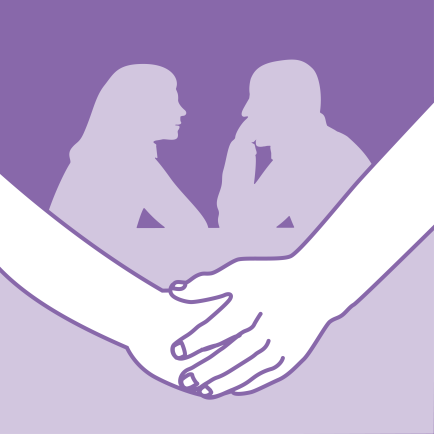Face to Face

Face to Face
Why do we make the effort to meet face-to-face in our support groups? There is good information to learn and to share. But that’s not all.
In coming together face-to-face, there to a total experience of engaging, seeing, relating and responding. We open ourselves to that what makes us individually unique and that what makes us universally human. This direct meeting facilitates encountering the feelings of the others and the contexts of their lives to experience them as whole persons. But to experience another, one must first be able to experience one’s own self. Here, face-to-face, there is an opportunity to be oneself. If one truly sees oneself and the other person, one becomes interested in the inner lives of both, one stops thinking and judging, and there is a sense of sharing and human solidarity. This is a very therapeutic experience — at that moment one no longer feels isolated.
We also understand that not everyone can make it to the face-to-face meetings. We have opened them to remote audio- and web-conferencing. Joining remotely is not the same as being there, but web-conferencing technology can bridge the distance gap and overcome the health barrier. Whether in a room together or seeing one another through the conferencing screens, our desire is to create a genuine feeling of connectedness, of knowing, of understanding.
There is freshness and energy in our meetings. There is a sense of relatedness, of love, of concern. And there I have met very wise people who are attracted by the process of living in all its spheres, from the rooting and sprouting of the tomato and flower seeds to the growth and expression of one’s human potentialities. Being with them is a deep teaching on how to love and celebrate life.
The many people we meet on this human journey actively shape it and enrich it through their lives. Please come and join us. And I invite everyone with an interest to start a support group in his/her community to please reach out. We will work with you to bring it into momentum and keep it in being.
Measuring Quality
Last month the Journal of the American Medical Association (JAMA) published a moving account by two parents of their son’s long journey towards a diagnosis. They write,
Most of the health care professionals he saw were compassionate and caring. We received lots of empathy—but no diagnosis.
Their son, Mathew, born with Down syndrome, began experiencing a “tectonic shift” in his personality by his 17th birthday.
His mood was not the only change. There was an initial period of substantial weight loss. There were days of abdominal pain, nausea, and emesis, mystifyingly intermittent.
His pediatrician referred him to a gastroenterologist but an endoscopy was unrevealing. […] Repeated endoscopies were also unrevealing. Much of his symptom burden was attributed to anxiety and depression in a young adult with Down syndrome and poor articulation, and he was handed off to a psychologist and a psychiatrist.
Seven years later, Mathew was finally diagnosed with celiac disease by his new primary care physician where the family has recently moved.
What allowed Matthew’s doctor to identify the diagnosis that so many others had missed? Certainly, she was compassionate and well-trained, but so were the prior clinicians. […] she cared about people with intellectual disabilities—enough to have such individuals be a focus of her practice, and for their families to know of her, and recommend her to us. She cared about her patients enough to read the sparse literature on gastrointestinal and mood disorders in Down syndrome, even though this would never be an expected question in board certification tests.
Now living healthy and approaching the third decade of his life, his parents question the meaning of quality measures and online commercial survey-based reports of physicians.
The value of Matthew living his best life and of being able to again raise our children without fear of harm—priceless for our family—has not, to the best of our knowledge, been captured by any quality metric.
Reading this reminded me of the conclusion in Dr. Robert Wachter’s opinion piece in the New York Times a few years ago: “How Measurement Fails Doctors and Teachers.”
Avedis Donabedian, a professor at the University of Michigan’s School of Public Health, was a towering figure in the field of quality measurement. He developed what is known as Donabedian’s triad, which states that quality can be measured by looking at outcomes (how the subjects fared), processes (what was done) and structures (how the work was organized). In 2000, shortly before he died, he was asked about his view of quality. What this hard-nosed scientist answered is shocking at first, then somehow seems obvious.
“The secret of quality is love,” he said.
Be well,
Aliaa